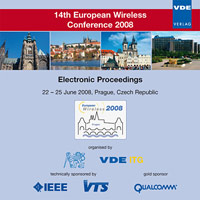Considerations on Forwarder Selection for Opportunistic Protocols in Wireless Networks
Konferenz: European Wireless 2008 - 14th European Wireless Conference
22.06.2008 - 25.06.2008 in Prague, Czech Republic
Tagungsband: European Wireless 2008
Seiten: 7Sprache: EnglischTyp: PDF
Persönliche VDE-Mitglieder erhalten auf diesen Artikel 10% Rabatt
Autoren:
Zubow, Anatolij; Kurth, Mathias; Redlich, Jens-Peter (Humboldt University, Germany)
Inhalt:
Opportunistic Routing gained lots of attention as a way to improve the performance of wireless multi-hop relay mesh networks. The key characteristic is its ability to take advantage of the numerous, yet unreliable wireless links in the network. The most important part of every opportunistic routing protocol is the forwarder selection algorithm. Most of the currently known protocols assume that signal paths from a sender to all candidates are independent to each other and therefore resulting in independent packet error rates. However, this assumption does not hold for spatially close candidates which are not so uncommon in indoor networks. In this paper, we present empirical measurements from our 802.11 indoor testbed which reveal that signal paths to spatially close nodes are correlated. We believe that the loss in the radio propagation due to shadow fading is similar to spatially close nodes. For our setup we find out that a spatial correlation exists when the nodes are closer than 2m to each other. We present a candidate set selection algorithm which is able to calculate the packet error rate of a candidate set even when the individual packet error rates are correlated, e.g. due to spatial correlation. Therefore only a simple modification to the existing ordinary link probing is required. Finally, we present modifications we made to our packet-level simulator to respect spatial correlation as well as simulation results.


